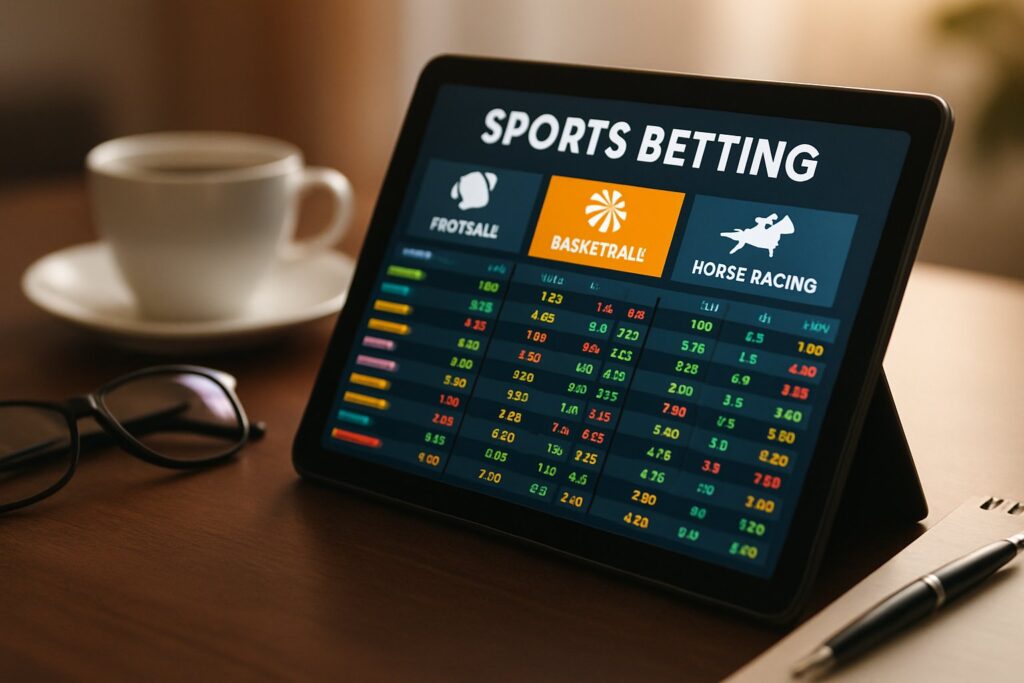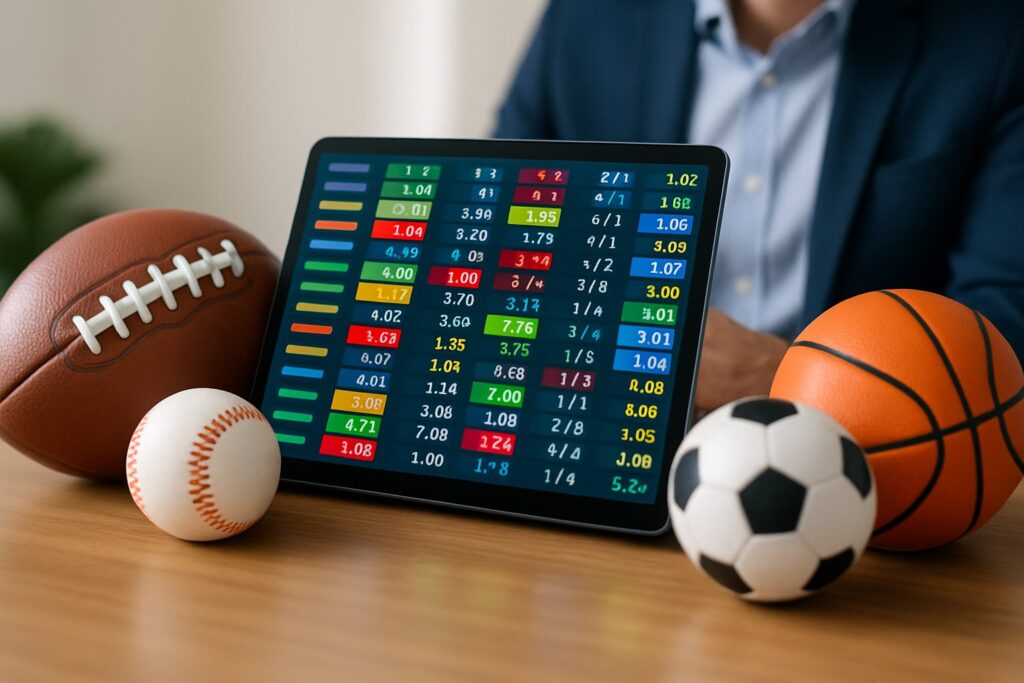by Martin Green
August 9, 2025
Last Updated on August 9, 2025 by Martin Green
Sports wagering odds basically show how likely something is to happen and what you might get paid if you’re right. They spell out your potential winnings based on what you risk and how probable the outcome is. Whether you’re eyeing a single game or the whole season, getting a grip on odds is the first step to betting smart.

You can use odds to line up potential bets, sniff out value in different markets, and tweak your strategy as lines move. Sportsbooks set these numbers using team performance, player stats, injuries, and a bunch of other details. If you know how to read and interpret them, you’ll see the playing field a lot more clearly before putting your money down.
From moneylines and point spreads to totals and prop bets, each odd type gives you a unique way to look at a game. Figuring out how they work helps you pick the market that fits your goals and dodge some classic mistakes that can eat away at your bankroll.

Sports wagering odds lay out the chances of an outcome and show what you stand to win. They’re based on probability and come in different formats depending on where you’re betting. If you understand them, you can size up risk, compare bets, and figure out what you might pocket if you win.
Odds reflect how the bookmaker sees the probability of an event. They also build in a margin – the vig or juice – which is just the sportsbook’s cut.
When a team looks more likely to win, the odds come with a smaller payout. If the team’s an underdog, you get a bigger payout if they pull off the win.
Say you see odds of -150: you’d need to bet $150 to win $100. If the odds are +150, a $100 bet nets you $150 profit.
Sportsbooks move odds around as bets come in, or if there are injuries or other shake-ups. That way, they try to keep their risk balanced and make sure they profit, no matter the result.
Sportsbooks use three main odds formats:
| Format | Example | Meaning |
|---|---|---|
| American | -200 | Bet $200 to win $100 (favorite) |
| American | +200 | Bet $100 to win $200 (underdog) |
| Decimal | 1.50 | Total return is stake × 1.50 |
| Fractional | 1/2 | Win 1 unit for every 2 units staked |
American odds are standard in the US and use plus (+) and minus (-) signs.
Decimal odds are the go-to in Europe, Asia, and Australia, showing your total return (including your stake).
Fractional odds are classic in the UK and Ireland, especially for horse racing.
If you want, you can convert between formats to compare deals across sportsbooks.
A betting line lays out the odds for each outcome in an event. The usual suspects are moneyline (who wins), point spread (by how much), and totals (over/under points).
Example – NFL game:
Patriots -7 (-110) means the Patriots need to win by more than 7 points, and you’d risk $110 to win $100.
Always look at both the numbers and the symbols. The plus or minus, the value, and the type of bet all shift your potential payout and the risk.
If you check lines at different sportsbooks, you might spot better value for the same wager.

Sports wagering odds tell you what you could win and how likely an outcome is. They steer your betting choices by showing risk, possible payout, and how sportsbooks see each side of the matchup.
A moneyline bet is the most straightforward way to wager on sports. You just pick who you think will win – no point spread, nothing fancy.
Odds show up as a negative number for the favorite or a positive number for the underdog.
Example:
| Team | Odds | Bet $100 Result |
|---|---|---|
| Team A | -150 | Win $66.67 profit |
| Team B | +130 | Win $130 profit |
You’ll risk more on favorites and less on underdogs, but underdogs pay out more if they win. This format pops up a lot in U.S. sports like baseball, hockey, and boxing.
A point spread tries to level the playing field between teams of different strengths. The favorite has to win by more than the spread, while the underdog can lose by less than that number or win outright for your bet to hit.
Example:
Both sides usually sit near -110 odds, so you’d bet $110 to win $100. This style is big in football and basketball because those sports have the right scoring for spreads.
Point spreads make you think about the margin of victory, not just who wins, which changes how you break down the matchup.
Totals – or over/under bets – are all about the combined score. The sportsbook sets a number, and you pick if the actual total will be higher (over) or lower (under).
Example: If the total is 47.5 in football:
Odds for both sides usually hover around -110, just like point spreads. Totals work for basketball, soccer, baseball, and more – they’re handy if you want to bet on game pace or defense instead of picking a winner.
Some betting options span weeks or months, while others combine several picks into one wager. These markets demand that you know how odds and payouts work, and what risks you’re taking, before you jump in.
A futures bet is a wager on something that’ll be decided down the road, maybe weeks or even months away. Think picking the league champ, a tournament winner, or who’ll snag a season award.
Futures odds usually drop before the season or event starts and shift as teams play, injuries happen, or the market moves. You might get juicier odds early, but the risk ramps up since so much can change.
These bets mostly use the moneyline format. For example:
| Outcome | Futures Odds | $100 Bet Payout |
|---|---|---|
| Team A wins championship | +500 | $600 total |
| Team B wins championship | +1200 | $1,300 total |
If you want to find value, you’ll need to track news, standings, and player injuries or trades. Some sportsbooks let you cash out early, but that usually means taking a smaller profit than if you waited until the end.
A parlay wager bundles two or more bets into one ticket. To win, you need every pick to hit. If one misses, the whole parlay’s a bust.
Parlays can mix spreads, moneylines, totals, or even futures. The payout shoots up compared to single bets, but so does the risk with each extra pick.
For example:
| Bet Type | Selection | Odds |
|---|---|---|
| Spread | Team A -3.5 | -110 |
| Moneyline | Team B to win | +150 |
| Total | Over 45.5 points | -105 |
If all three hit, you get a much bigger payout. But the odds of winning drop with every extra leg, so you’ve got to weigh the potential reward against the real chances of hitting them all.
Each sport has its own betting lines that tweak how you judge risk and payout. These formats often bring in a fixed spread or other quirks, so knowing the rules and structure helps you make smarter bets.
The run line is baseball’s answer to the point spread. It’s almost always set at -1.5 runs for the favorite and +1.5 runs for the underdog.
If you bet the favorite at -1.5, they’ve got to win by two or more runs for you to cash out. The underdog at +1.5 can win outright or lose by just one run and still cover the bet.
Run line odds don’t always match moneyline odds. For example:
| Team | Run Line | Odds |
|---|---|---|
| Yankees | -1.5 | +120 |
| Red Sox | +1.5 | -140 |
If you take the run line on a strong favorite, you might get a higher payout, but you’re betting on a bigger win margin. On the flip side, betting the underdog with +1.5 gives you a little cushion, but usually pays out less.
The puck line works a lot like the run line but for hockey. You’ll almost always see it set at -1.5 goals for the favorite and +1.5 goals for the underdog.
If you take the favorite at -1.5, that team has to win by two or more goals. The underdog at +1.5 can either win outright or lose by just one goal and still cover the bet.
Example:
| Team | Puck Line | Odds |
|---|---|---|
| Maple Leafs | -1.5 | +150 |
| Canadiens | +1.5 | -170 |
Since hockey games are usually low-scoring, covering -1.5 can be a real challenge compared to baseball. Lots of folks lean toward +1.5 in close matchups, trading lower odds for a better shot at winning.
Sports betting odds start with some heavy data work, but they shift all the time as money comes in. Pro bettors often move the lines early, while the public can nudge things later, especially when a game gets popular. Both groups shape the odds, keeping them pretty accurate and balanced most of the time.
Oddsmakers build opening lines using statistical models, past results, and team metrics. They’re trying to predict outcomes and drum up even betting on both sides.
Things like injuries, weather, home-field advantage, and recent form all get baked into the odds. If a football team loses its starting quarterback, you might see the spread swing by a few points before bets even open.
Algorithms chew through piles of stats, from win probabilities to scoring trends. But oddsmakers also lean on their own judgment for stuff the models might miss – coaching shakeups, travel fatigue, that sort of thing.
At sharp sportsbooks, early lines get stress-tested by big-money pro bettors. If those bettors hammer one side right away, the sportsbook will tweak the odds or spread to fix any weak spots.
Retail sportsbooks usually just copy these adjusted lines instead of making their own. That way, they stay in step with the market and protect themselves with bigger margins.
Once lines go up, they rarely sit still. As bets roll in, sportsbooks watch the action and try to keep things balanced.
If the public piles onto one side, the line might move to make the other side more tempting. So a -3 favorite could become -3.5 or -4 to get more bets on the underdog.
Sharp money tends to move lines faster and further than public money. Pros usually bet early, forcing quick changes, while the public jumps in closer to game time.
Sportsbooks also react fast to breaking news. A sudden injury or weather update can shift both point spreads and moneyline odds right away.
Sometimes, public hype can push a line away from its true odds, and that leaves opportunities for bettors who spot when the market’s gone too far.
Betting can be fun if you keep a close eye on your time and money and watch out for warning signs. Staying disciplined with your bets protects your wallet, your headspace, and your relationships too.
Set a clear betting budget that only uses money you can actually spare – what’s left after the bills are paid. Never touch cash meant for rent, groceries, or other must-haves.
Break up your budget into smaller chunks. Maybe just deposit part of your monthly allowance at a time so you don’t blow it all at once.
Lots of people stick to risking only 1-5% of their bankroll on one bet. That way, losses sting less and your betting lasts longer.
Most sportsbooks offer tools to set deposit or loss limits. Use them if you need to – you can lock in those settings so you can’t go over during that period.
If you hit your limit for the day or week, just stop. Don’t chase losses – that’s an easy way to spend more than you planned.
Problem gambling can sneak up on you. Watch for these warning signs:
| Behavior | What to Watch For |
|---|---|
| Chasing losses | Placing bigger bets to recover money lost |
| Neglecting responsibilities | Skipping work or social events to gamble |
| Borrowing money | Using credit or loans to keep betting |
| Hiding activity | Lying about time or money spent gambling |
If you spot these signs in yourself, do something about it right away. Self-exclusion tools can block your access for a set time.
Need help? Call 1-800-GAMBLER if you’re in the US. You can also look into counseling, check out Gamblers Anonymous, or use online chat services from gambling help groups.
Sports betting odds come from a mix of stats and market action. You can use them to guess probabilities, compare payouts, and maybe spot a good opportunity or two.
Oddsmakers use stats, past results, and expert opinions to set the lines.
They look at team strength, player matchups, injuries, and where the game is played. The idea is to set lines that pull in bets on both sides.
Odds can shift because of injuries, lineup changes, weather, or just a flood of bets.
Big bets from respected players can make sportsbooks move the lines to manage risk.
Odds comparison websites let you see prices from different books side by side.
Checking a few sources before betting helps you find the best payout for the same pick.
Online bet calculators can turn American, decimal, or fractional odds into exact payouts.
Most sportsbooks show your possible return on the bet slip before you hit confirm.
Look for gaps between your own odds and what’s posted.
Keep an eye on injury news, team schedules, and recent results. Try not to just follow the crowd or get swept up in hype.
You can check out sports news sites, statistical databases, and well-known betting forums for free analysis and data.
Some sportsbooks also give you match previews, trend reports, and odds history to help with your research.